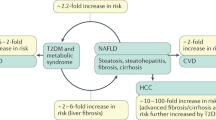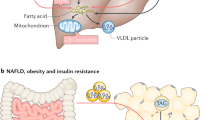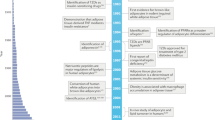Abstract
There is increasing evidence that visceral adipose tissue is a causative risk factor for fatty liver and nonalcoholic steatohepatitis. Adipose tissue-derived secretory proteins are collectively named adipocytokines. Obesity and mainly visceral fat accumulation impair adipocyte function and adipocytokine secretion and the altered release of these proteins contributes to hypertension, impaired fibrinolysis and insulin resistance. This review summarizes recent findings on the role of the adipocytokines adiponectin, leptin and resistin in the context of hepatic insulin resistance, fatty liver and liver fibrosis. Elevated levels of resistin antagonize hepatic insulin action and raise plasma glucose levels. Leptin exerts insulin-sensitizing effects, but obesity has been linked to leptin resistance and low levels of circulating leptin receptor, indicating that high levels of leptin cannot mediate its beneficial effects. Adiponectin improves insulin sensitivity; however, low circulating adiponectin is found in the obese state. Adiponectin is an anti-inflammatory protein, whereas leptin augments inflammation and fibrogenesis. Disturbed adipocytokine secretion might, therefore, promote hepatic steatosis and the development of nonalcoholic steatohepatitis. The beneficial effects of the therapeutic approaches so far tested in the treatment of fatty liver disease and fibrosis might be due to the modulation of these adipocytokines.
This is a preview of subscription content, access via your institution
Access options
Subscribe to this journal
Receive 12 print issues and online access
$209.00 per year
only $17.42 per issue
Buy this article
- Purchase on Springer Link
- Instant access to full article PDF
Prices may be subject to local taxes which are calculated during checkout



Similar content being viewed by others
References
Browning JD and Horton JD (2004) Molecular mediators of hepatic steatosis and liver injury. J Clin Invest 114: 147–152
McClain CJ et al. (2004) Mechanisms of non-alcoholic steatohepatitis. Alcohol 34: 67–79
Chitturi S and Farrell GC (2001) Etiopathogenesis of nonalcoholic steatohepatitis. Semin Liver Dis 21: 27–41
Omagari K et al. (2002) Fatty liver in non-alcoholic non-overweight Japanese adults: incidence and clinical characteristics. J Gastroenterol Hepatol 17: 1098–1105
Kral JG et al. (1993) Body fat topography as an independent predictor of fatty liver. Metabolism 42: 548–551
Dusserre E et al. (2000) Differences in mRNA expression of the proteins secreted by the adipocytes in human subcutaneous and visceral adipose tissues. Biochim Biophys Acta 1500: 88–96
Lafontan M and Berlan M (2003) Do regional differences in adipocyte biology provide new pathophysiological insights? Trends Pharmacol Sci 24: 276–283
Fain JN et al. (2004) Comparison of the release of adipokines by adipose tissue, adipose tissue matrix, and adipocytes from visceral and subcutaneous abdominal adipose tissues of obese humans. Endocrinology 145: 2273–2282
Lihn AS et al. (2004) Lower expression of adiponectin mRNA in visceral adipose tissue in lean and obese subjects. Mol Cell Endocrinol 219: 9–15
Frayn KN (2000) Visceral fat and insulin resistance—causative or correlative? Brit J Nutr 83 (Suppl 1): S71–S77
Meek SE et al. (1999) Insulin regulation of regional free fatty acid metabolism. Diabetes 48: 10–14
Taskinen MR (2003) Diabetic dyslipidemia: from basic research to clinical practice. Diabetologia 46: 733–749
Pessayre D et al. (2002) Nonalcoholic steatosis and steatohepatitis. V. Mitochondrial dysfunction in steatohepatitis. Am J Physiol Gastrointest Liver Physiol 282: G193–G199
Lee YH and Pratley RE (2005) The evolving role of inflammation in obesity and the metabolic syndrome. Curr Diab Rep 5: 70–75
Li Z et al. (2003) Probiotics and antibodies to TNF inhibit inflammatory activity and improve nonalcoholic fatty liver disease. Hepatology 37: 343–350
Chandran M et al. (2003) Adiponectin: more than just another fat cell hormone? Diabetes Care 26: 2442–2450
Yamauchi T et al. (2003) Cloning of adiponectin receptors that mediate antidiabetic metabolic effects. Nature 423: 762–769
Zietz B et al. (2003) Adiponectin represents an independent cardiovascular risk factor predicting serum HDL-cholesterol levels in type 2 diabetes. FEBS Lett 545: 103–104
Ng TW et al. (2005) Adipocytokines and VLDL metabolism: independent regulatory effects of adiponectin, insulin resistance, and fat compartments on VLDL apolipoprotein B-100 kinetics? Diabetes 54: 795–802
Shklyaev S et al. (2003) Sustained peripheral expression of transgene adiponectin offsets the development of diet-induced obesity in rats. Proc Natl Acad Sci U S A 100: 14217–14222
Xu A et al. (2003) The fat-derived hormone adiponectin alleviates alcoholic and nonalcoholic fatty liver diseases in mice. J Clin Invest 112: 91–100
Diez JJ and Iglesias P (2003) The role of the novel adipocyte-derived hormone adiponectin in human disease. Eur J Endocrinol 148: 293–300
Tsuchida A et al. (2004) Insulin/Foxo1 pathway regulates expression levels of adiponectin receptors and adiponectin sensitivity. J Biol Chem 279: 30817–30822
Masaki T et al. (2004) Adiponectin protects LPS-induced liver injury through modulation of TNF-α in KK-Ay obese mice. Hepatology 40: 177–184
Kamada Y et al. (2003) Enhanced carbon tetrachloride-induced liver fibrosis in mice lacking adiponectin. Gastroenterology 125: 1796–1807
Lopez-Bermejo A et al. (2004) Adiponectin, hepatocellular dysfunction and insulin sensitivity. Clin Endocrinol Oxf 60: 256–263
Hui JM et al. (2004) Beyond insulin resistance in NASH: TNF-α or adiponectin ? Hepatology 40: 46–54
Targher G et al. (2004) Decreased plasma adiponectin concentrations are closely associated with nonalcoholic hepatic steatosis in obese individuals. Clin Endocrinol Oxf 61: 700–703.
Kaser S et al. (2005) Adiponectin and its receptors in non-alcoholic steatohepatitis. Gut 54: 117–121
Vuppalanchi R et al. (2005) Is adiponectin involved in the pathogenesis of nonalcoholic steatohepatitis? A preliminary human study. J Clin Gastroenterol 39: 237–242
Tietge UJ et al. (2004) Elevated circulating adiponectin levels in liver cirrhosis are associated with reduced liver function and altered hepatic hemodynamics. Am J Physiol Endocrinol Metab 287: E82–E89
Poordad FF (2004) The role of leptin in NAFLD contender or pretender? J Clin Gastroenterol 38: 841–843
Montague CT et al. (1997) Congenital leptin deficiency is associated with severe early-onset obesity in humans. Nature 387: 903–908
Kakuma T et al. (2000) Leptin, troglitazone, and the expression of sterol regulatory element binding proteins in liver and pancreatic islets. Proc Natl Acad Sci U S A 18: 8536–8441
Lee Y et al. (2002) PPAR alpha is necessary for the lipogenic action of hyperleptinemia on white adipose and liver tissue. Proc Natl Acad Sci U S A 99: 11848–11853
Cohen P and Friedman JM (2004) Leptin and the control of metabolism: role for stearoyl-CoA desaturase-1 (SCD-1). J Nutr 134: 2455S–2463S
Sandhofer A et al. (2003) Soluble leptin receptor and soluble receptor-bound fraction of leptin in the metabolic syndrome. Obes Res 11: 760–768
Tobe K et al. (1999) Relationship between serum leptin and fatty liver in Japanese male adolescent university students. Am J Gastroenterol 94: 3328–3335
Serin E et al. (2003) Serum leptin level can be a negative marker of hepatocyte damage in nonalcoholic fatty liver. J Gastroenterol 38: 471–476
Marra F (2002) Leptin and liver fibrosis: a matter of fat. Gastroenterology 122: 1529–1532
Cao Q et al. (2004) Leptin stimulates tissue inhibitor of metalloproteinase-1 in human hepatic stellate cells: respective roles of the JAK/STAT and JAK-mediated H2O2-dependent MAPK pathways. J Biol Chem 279: 4292–4304
Saxena NK et al. (2004) Leptin as a novel profibrogenic cytokine in hepatic stellate cells: mitogenesis and inhibition of apoptosis mediated by extracellular regulated kinase (Erk) and Akt phosphorylation. FASEB J 18: 1612–1614
Ikejima K et al. (2002) Leptin receptor-mediated signaling regulates hepatic fibrogenesis and remodeling of extracellular matrix in the rat. Gastroenterology 122: 1399–1410
Meier U and Gressner AM (2004) Endocrine Regulation of energy metabolism: review of pathobiochemical and clinical chemical aspects of leptin, ghrelin, adiponectin, and resistin. Clin Chem 50: 1511–1525
Banerjee RR et al. (2004) Regulation of fasted blood glucose by resistin. Science 303: 1195–1198
Sato N et al. (2005) Adenovirus-mediated high expression of resistin causes dyslipidemia in mice. Endocrinology 146: 273–279
McTernan PG et al. (2002) Increased resistin gene and protein expression in human abdominal adipose tissue. J Clin Endocrinol Metab 87: 2407
Laimer M et al. (2002) Weight loss increases soluble leptin receptor levels and the soluble receptor bound fraction of leptin. Obes Res 10: 597–601
Valsamakis G et al. (2004) Modest weight loss and reduction in waist circumference after medical treatment are associated with favorable changes in serum adipocytokines. Metabolism 53: 430–434
Lin HZ et al. (2000) Metformin reverses fatty liver disease in obese, leptin-deficient mice. Nat Med 6: 998–1003
Uygun A et al. (2004) Metformin in the treatment of patients with non-alcoholic steatohepatitis. Aliment Pharmacol Ther 19: 537–544
Kay JP et al. (2001) Beneficial effects of metformin in normoglycemic morbidly obese adolescents. Metabolism 50: 1457–1461
Fruehwald-Schultes B et al. (2002) Short-term treatment with metformin decreases serum leptin concentration without affecting body weight and body fat content in normal-weight healthy men. Metabolism 51: 531–536
Tiikkainen M et al. (2004) Effects of rosiglitazone and metformin on liver fat content, hepatic insulin resistance, insulin clearance, and gene expression in adipose tissue in patients with type 2 diabetes. Diabetes 53: 2169–2176
Fujita H et al. (2002) Effect of metformin on adipose tissue resistin expression in db/db mice. Biochem Biophys Res Commun 298: 345–349
Bajaj M et al. (2004) Plasma resistin concentration, hepatic fat content, and hepatic and peripheral insulin resistance in pioglitazone-treated type II diabetic patients. Int J Obes Relat Metab Disord 28: 783–789
Kon K et al. (2002) Pioglitazone prevents early-phase hepatic fibrogenesis caused by carbon tetrachloride. Biochem Biophys Res Commun 291: 55–61
Acknowledgements
Figure 1 is a gift from Dr Frauke Bataille, whose generosity is highly appreciated.
Author information
Authors and Affiliations
Corresponding author
Ethics declarations
Competing interests
The authors declare no competing financial interests.
Glossary
- GLITAZONES
-
Insulin-sensitizing drugs such as pioglitazone or rosiglitazone that are used for the treatment of type 2 diabetes mellitus
- ADIPONECTIN
-
An anti-inflammatory and adipocyte-specific secretory protein, the levels of which decrease in the context of obesity-related insulin resistance
- KK-Ay OBESE MICE
-
The Ay mutation was introduced onto the KK strain background; mice of the KK strain develop diabetes of polygenic origin; Ay heterozygotes usually become obese and infertile within a few months after birth
- LEPTIN
-
The satiety hormone; leptin is mainly produced and secreted by mature adipocytes and acts mostly in the hypothalamus by decreasing neuropeptide Y synthesis and release
- RESISTIN
-
A protein produced during adipocyte differentiation, resistin is possibly linked to hepatic insulin resistance by interfering with hepatic gluconeogenesis
- METFORMIN
-
A biguanide hypoglycemic agent used in the treatment of type 2 diabetes mellitus for improving glycemic control
Rights and permissions
About this article
Cite this article
Schäffler, A., Schölmerich, J. & Büchler, C. Mechanisms of Disease: adipocytokines and visceral adipose tissue—emerging role in nonalcoholic fatty liver disease. Nat Rev Gastroenterol Hepatol 2, 273–280 (2005). https://doi.org/10.1038/ncpgasthep0186
Received:
Accepted:
Issue Date:
DOI: https://doi.org/10.1038/ncpgasthep0186
This article is cited by
-
Adipose tissue depot specific expression and regulation of fibrosis-related genes and proteins in experimental obesity
Mammalian Genome (2024)
-
The contribution of FTO rs9939609 and RETN rs1862513 polymorphisms in predisposing resettled indigenous (Orang Asli) Temiar to metabolic syndrome
Egyptian Journal of Medical Human Genetics (2023)
-
Association between metabolically healthy obesity and non-alcoholic fatty liver disease
Hepatology International (2022)
-
Bifidobacterial carbohydrate/nucleoside metabolism enhances oxidative phosphorylation in white adipose tissue to protect against diet-induced obesity
Microbiome (2022)
-
Accumulation of cholesterol, triglycerides and ceramides in hepatocellular carcinomas of diethylnitrosamine injected mice
Lipids in Health and Disease (2021)



